#ancient Near East
Text

Line drawing of an impression from the cylinder seal of Shar-Kali-Sharri, ruler of the Akkadian Empire ca. 2217-2193 BCE. On the right of the impression, the hero Gilgamesh wrestles with a lion. From The Seal Cylinders of Western Asia by William Hayes Ward, published in 1910.
#art#art history#ancient art#Ancient Near East#Mesopotamia#history#ancient history#Akkadian#Akkadian Empire#Shar-Kali-Sharri#cylinder seal#cuneiform#Gilgamesh
58 notes
·
View notes
Text
SO yesterday I had a guest professor who
spent well over 10 minutes showing us memes about Ea-Nasir
Wondered if the Babylonians wore skirts because of 'the flow down under'
Called like all the kings in the Ancient Near East cute
Called all of us darlings, multiple times
Casually brought VERY valuable clay tablets to our lesson in a tin cookie jar
Proudly exclaimed 'I'm the father' while explaining pregnant tablets (clay tablets with another clay tablet in them)
'What happens in the office between me and the tablets, stays in the office between me and the tablets'
Casually said he was the first ever to put a tablet in a particle accelerator LIKE LAST WEEK
Had an absolutely FIRE powerpoint
Showed us a picture of a cute dog just because
What a legend
121 notes
·
View notes
Text
If you ever get the chance to visit the Louvre in Paris or the Metropolitan Museum of Art in New York, take a detour to the Ancient Near Eastern Art Gallery. Keep walking until you find yourself in front of one of those cubic display cases, whose bulletproof glass protects a treasure barely bigger than your little finger. We call them Eye Idols. Carbon-14 tells us that they were made between 3000 and 3700 BC. Look closely, or at least think you're looking at them, because in reality it's quite the opposite. It's the Idol staring back at you; with the same puzzled, indecipherable look she gave the man who carved her out of stone 5,000 years ago. Those eyes have seen the first man, every man since, and they will be wide open long after the last man has closed his. For those eyes, your whole life will pass in less than a thousandth of a second. For them, there is only the eternal now. Feel how that look nails you to the ground and how your own can never have the same effect.
— 𝐕.






#prehistoric#art#history#paleoart#archeology#anthropology#stone age#louvre#museum#art history#paleolithic#ancient art#ancient rites#culture#sculpture#figurine#ancient history#rites#beliefs#cave art#ancient near east#history of art#art study#artwork#pagan#mystery#mystical#ancient#antiquity#world history
25 notes
·
View notes
Text
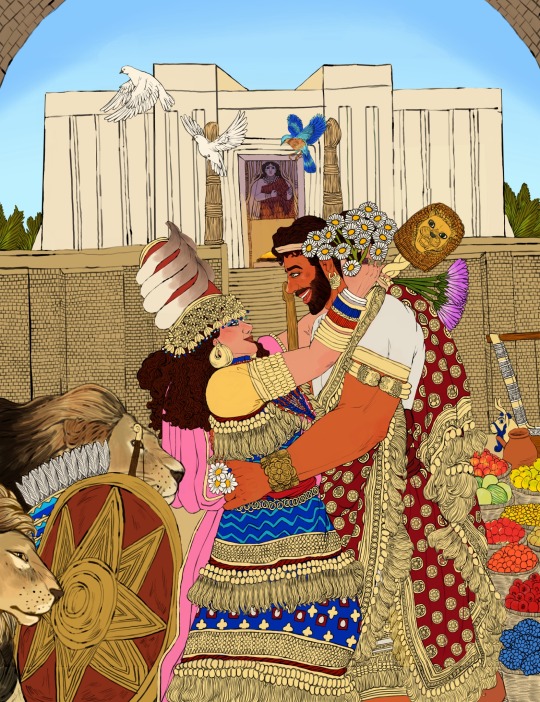

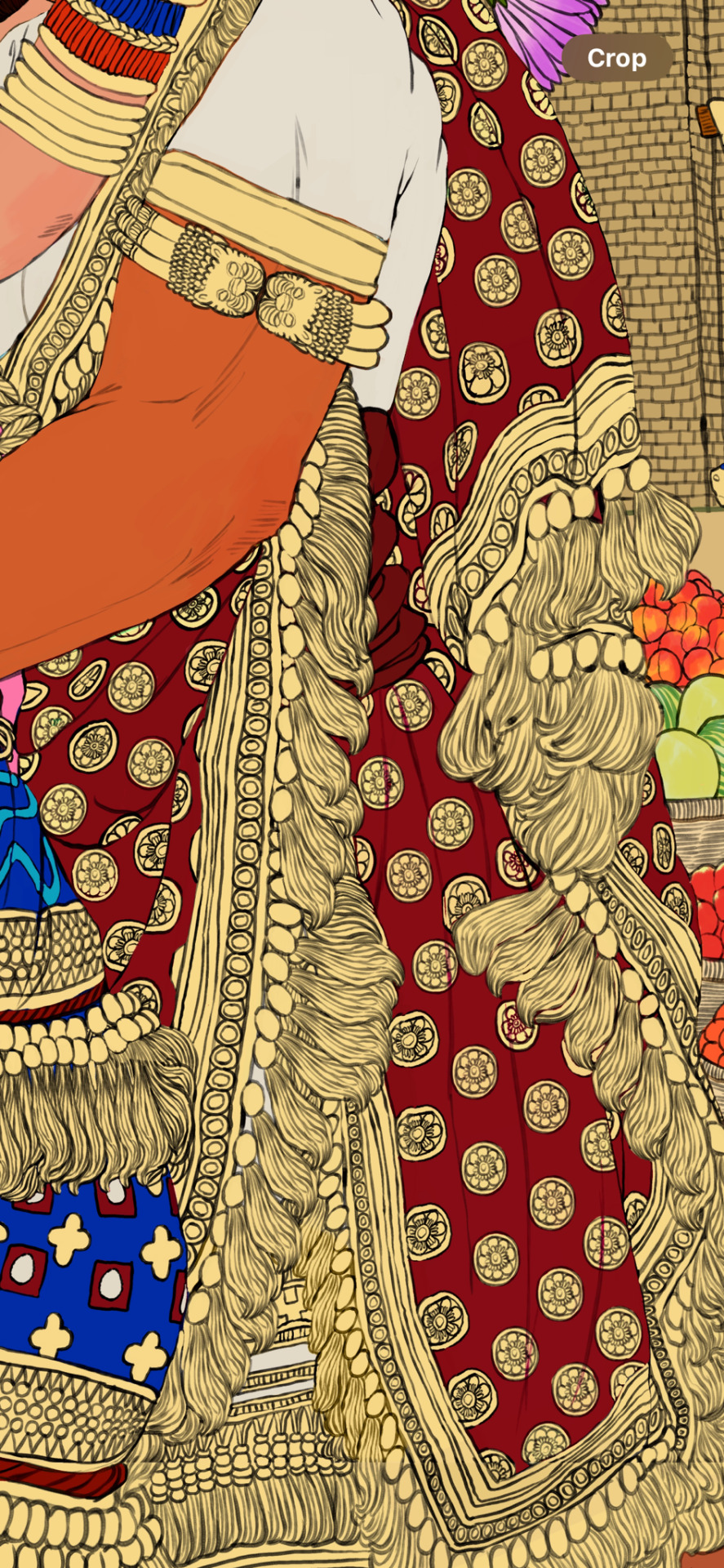

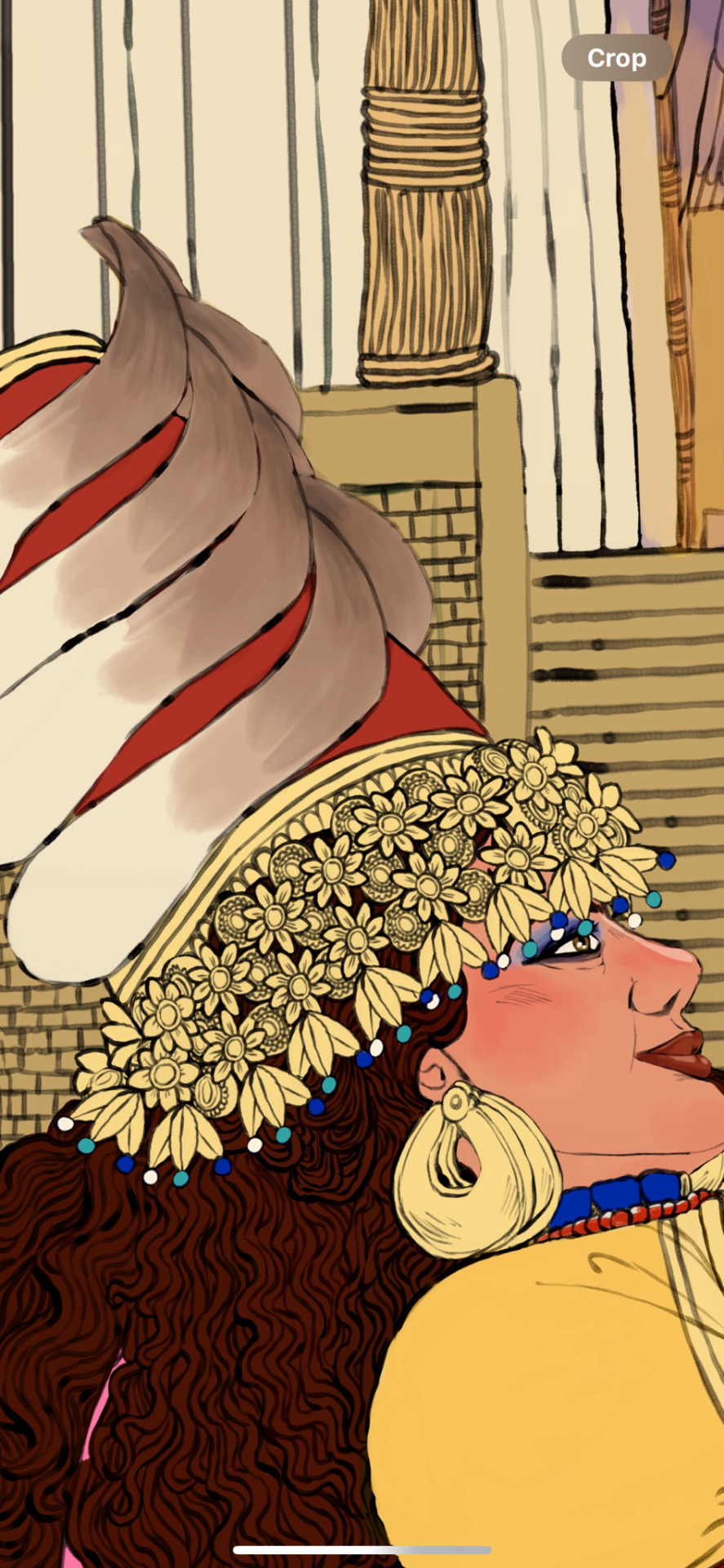
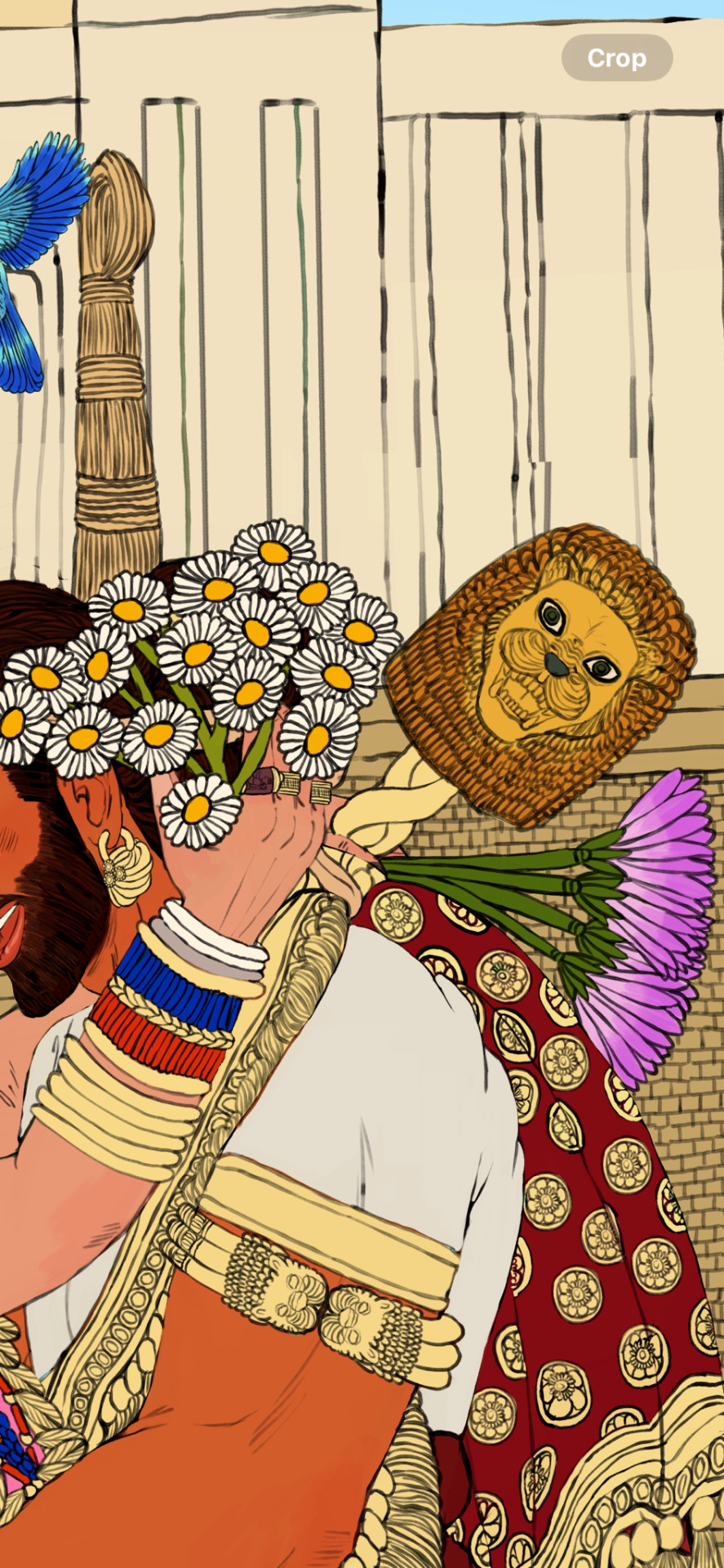
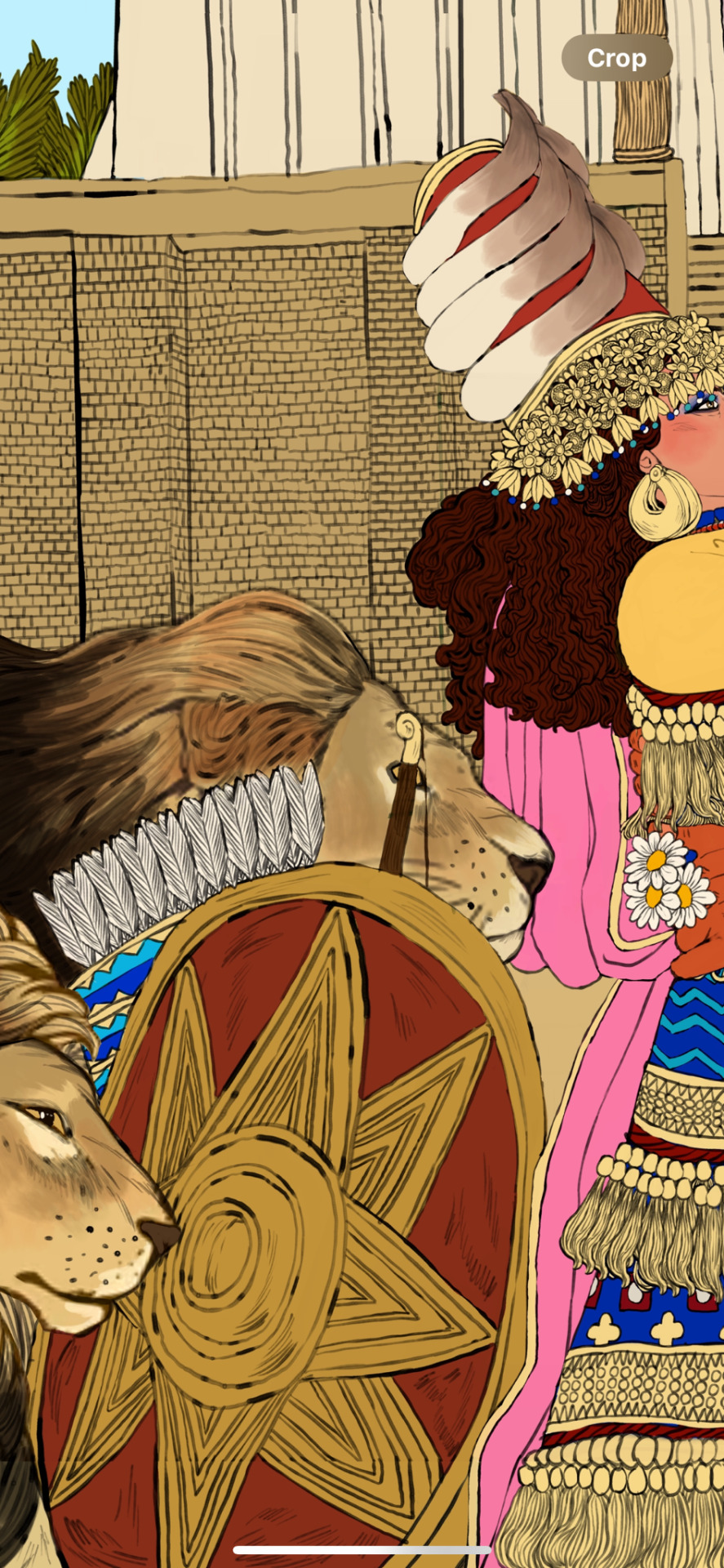
Aphrodite and Adonis in their older Mesopotamian forms; Inanna-Ishtar, the warlike goddess of beauty, fertility, and love and Dumuzi, her husband and the shepherd king of ageless Uruk.🦁🐏
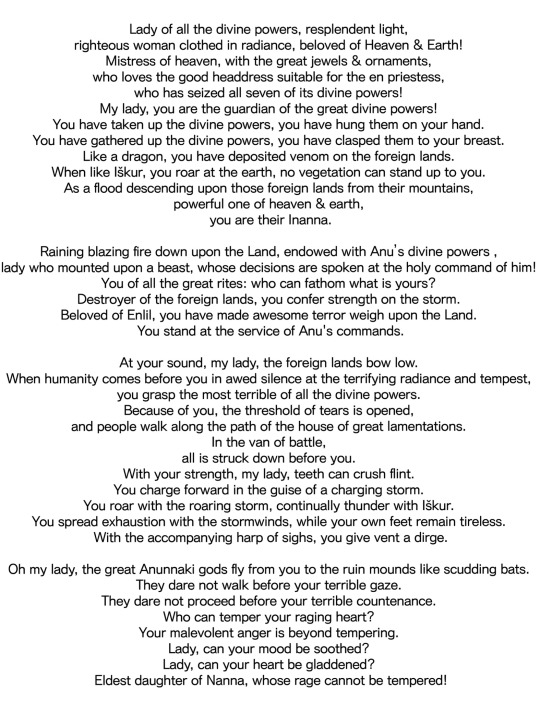
Here are the poem snippet that I used as the main inspo, written by Enhueduanna, high priestess of the moon god Nanna/Sin and daughter of King Sargon & Queen Tashlultum of Akkad. As she became a devotee of Inanna and composed various exaltation hymns to the goddess, she also composed 42 hymns addressed to many temples and sanctuaries across the land of Sumer and Akkad, the so-called Temple Hymns; which makes her become the earliest known named author in world history.
The ziggurat temple background was based on the Eanna temple (”House” of Inanna) in Uruk, which was built during the 3rd dynasty of Ur (21st cent BC) and had been mentioned throughout in the Epic of Gilgamesh; while their clothing was from later recent Assyrian & Babylonian era. All of the offerings were based on the depictions on the Warka vase from the National Museum of Iraq - an agricultural festival that seemed to be connected with the rituals involved with the goddess.
40 notes
·
View notes
Text
Gold Tablet from the Temple of Ištar in Aššur, Assyria (modern-day Iraq) c.1243-1207 BCE: this tablet was discovered within the foundations of the ancient temple; it measures just over 3cm (1in) in length
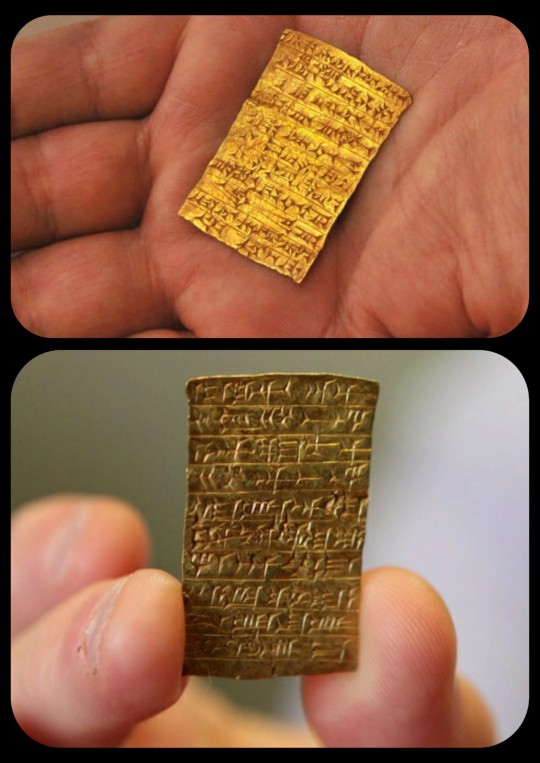
The cuneiform inscription honors King Tukulti-Ninurta I, who had ordered the construction of the temple, and describes how the building was constructed. This is just one of the many items that had been buried around the temple with similar inscriptions.
As this article explains:
Most of [the inscriptions installed in the temple] would not have been visible while the temple was still in use, as they were laid into the sanctuary’s foundations or walls. Tukulti-Ninurta commissioned a great number of objects carrying variations of the inscription commemorating his achievement of erecting the new temple.
The practice of depositing inscriptions directed at the gods as well as future generations had become a central element of the temple building process since the Early Dynastic Period, and was employed to immortalize the ruler by eternally associating his name with a monumental building such as the Ištar temple - a process that also transformed a sanctuary into a votive object dedicated to a deity.
It took several hours of searching (i.e. scouring through old artifact catalogs) for me to find a direct translation of the inscription on this particular tablet, and I could basically only find it in a PDF of an old bibliographic manuscript that isn't even in print anymore, but here it is:
Tukulti-Ninurta, king of the universe, king of Assyria, son of Shalmaneser, king of Assyria: at that time the temple of the goddess Ištar, my mistress, which Ilu-šumma, my forefather, the prince, had previously built — that temple had become dilapidated. I cleared away its debris down to the bottom of the foundation pit. I rebuilt from top to bottom and deposited my monumental inscription. May a later prince restore it and return my inscribed name to its place. Then Aššur will listen to his prayers.
This tablet was stolen from the Vorderasiatisches Museum in Berlin back in 1945, during the chaotic final days of WWII. It was then lost for almost 60 years before it finally re-emerged in 2006, when a Holocaust survivor named Riven Flamenbaum passed away and the tablet was found among his belongings. According to his family, Flamenbaum had gotten the tablet from a Soviet soldier (in exchange for two packs of cigarettes) at the end of the war.
In 2013, following a lengthy legal battle between Riven Flamenbaum's family and the Vorderasiatisches Museum in Germany, a court in New York ordered the family to return the tablet back to the museum.
Sources & More Info:
Albert Kirk Grayson: Assyrian Rulers of the Third and Second Millennia BC (to 1115 BC) (the translation appears on p.261)
Daniel Luckenbill: Ancient Records of Assyria and Babylonia, Volume 1 (PDF download; p.65 contains relevant info)
CTV News: 3,000-year-old Assyrian Gold Tablet Returned to German Museum
#archaeology#history#anthropology#ancient history#assyria#mesopotamia#golden tablet#cuneiform#artifact#ancient iraq#iraq#ancient near east#middle east#ishtar#pagan deities#polytheism#return the slab
348 notes
·
View notes
Text
📚Resources for The Ancient Near East📚
With a focus on religion
Getting Started On Research
JSTOR Guide LINK
Lumenlearning Guide LINK
Center for Online Education Guide LINK
Layman's Guide to Online Research by @/sisterofiris LINK
How to Vet Sources by me LINK
Websites for ANE Study
ETCSL | The Electronic Text Corpus of Sumerian Literature — http://etcsl.orinst.ox.ac.uk/catalogue.htm
ePSD | The Electronic Pennsylvania Sumerian Dictionary — http://psd.museum.upenn.edu/epsd-frame.html
ORACC | Open Richly Annotated Cuneiform Corpus — http://oracc.museum.upenn.edu/
ORACC's Mesopotamian Gods and Goddesses Project — http://oracc.iaas.upenn.edu/amgg/abouttheproject/index.html
ETANA | Electronic Tools & Ancient Near East Archive — http://etana.org/
CDLI | Cuneiform Digital Library Initiative — https://cdli.mpiwg-berlin.mpg.de/about
CAD | The Assyrian Dictionary of the Oriental Institute of the University of Chicago — http://www.aina.org/cad.html
Livius' Babylonian Section — https://www.livius.org/category/babylonia/
Multi Source Websites
Internet Archive Library — https://archive.org/details/texts | How To Use LINK
JSTOR — https://www.jstor.org/ | How To Use LINK
Google Scholar — https://scholar.google.com/intl/en/scholar/help.html
Google Books — https://books.google.com/googlebooks/about/index.html
Academia — https://support.academia.edu/hc/en-us/categories/360003163373-Academia-Free-Features
DOAJ Index of Open Access Journals — https://www.doaj.org/
Internet Ancient History Sourcebook — https://sourcebooks.fordham.edu/ancient/asbook.asp
Met Museum Publications — https://www.metmuseum.org/met-publications
Holy Books — https://www.holybooks.com/about/
Internet Sacred Text Archive — https://sacred-texts.com/
Deepdyve is a website of academic journal articles that isn't free but it isn't outrageously expensive for what it offers if you are heavily invested in new research — https://www.deepdyve.com/
Please leave a comment if a link breaks I'll do my best to find a new one
I'm planning to probably break these down into their own post due to link limit!
Books
*When using older books be aware that there may be inaccuracies and out of date information. If at all possible cross-reference and synthesize with newer materials. I have added years for this reason.
Books Specifically on Religion
Introduction to Ancient Mesopotamian Religion by Tammi Schneider (2011) Google Books | Good overview, 130ish page easy read.
Gods Demons and Symbols of Ancient Mesopotamia by Jeremy Black and Anthony Greene (1992) Internet Archive
Ancient Near Eastern Mythology by Gwendolyn Leick (1991) Internet Archive | This & Black's dictionary are good starting off points but I always use additional source's because some of Leick's info tends to be more out of date than other authors.
The Ancient Gods by E O James (1960) Internet Archive
The Cultic Calendars of the Ancient Near East by Mark Cohen (1993) PDF
Preforming Death Social Analysis of Funerary Traditions in the Ancient Near East and Medditarian edited by Nicola Laneri (2007) PDF
Mesopotamian Ritual-prayers of “Hand-lifting”(Akkadian Šuillas) by Christopher G Frechette Internet Archive
When Gods Were Men: The Embodied God in Biblical and Near Eastern Literature by Esther Hamon Internet Archive
Stories From Ancient Canaan by Michael D. Coogan and Mark S. Smith (1901) 1st Edition Internet Archive | 2nd Edition Google Books
A Handbook to Gods and Goddesses of the Ancient Near East (2021) Google Books
The City of the Moon God by Tamara Green (1992) Google Books
The Myth of Sacred Prostitution in Antiquity by Stephanie Lynn Budin (2008) Google Books
Books on ANE History in General
Handbook to Life in Ancient Mesopotamia by Stephen Bertman (2005) Google Books | Highly recommended, easy read
Ancient Mesopotamia Portrait of Dead Civilization by A. Leo Oppenheim (1964) Internet Archive
A History of the Ancient Near East ca. 3000- 323BC by Marc Van de Mieroop (2016) Internet Archive
Everyday Life in Ancient Mesopotamia by Jean Bottero (1992) Internet Archive
Women in the Ancient Near East by Marten Stol (2016) Open Access
Chapter 3 Elamite from The Cambridge Encyclopedia of Ancient World Languages edited by Roger Wooard (2004) PDF
Sumerian Art by Andre Parrot (1970) Digital Library
Dictionaries of Civilization Mesopotamia: Assyrians, Sumerians, Babylonians by Enrico Ascalone and Simona Schultz (2007) Publisher Website Entry
The Greek Magical Papyri in Translation, Including the Demotic Spells edited by Hans Dieter Betz PDF (If that link breaks Google Books)
Babylon: Mesopotamia and The Birth of Civilization by Paul Kriwaczek (2012) Google Books
Daily Life in Ancient Mesopotamia by Karen Rhea Nemet-Nejat (2002) Google Books
Mesopotamia to Iraq A Concise History by Hans Nissen (2009) Google Books
In the Land of A Thousand Gods: A History of Asia Minor in the Ancient World by Christian Marek (2016) Google Books
Mesopotamia: The Invention of the City by Gwendolyn Leick (2002) Google Books
Palmyra by Paul Veyne (2017) Google Books
The Ancient Near East c. 3000-330 BC Volume 1 by Amélie Kuhrt (1995) Google Books
The Ancient Near East c. 3000-330 BC Volume 2 by Amélie Kuhrt (1995) Google Books
The Image of the Netherworld in the Sumerian Sources by Diana Katz (2003) Google Books
Journal Articles
Mesopotamian Pandemonium by Frans Wiggermann LINK
Nergal A by Frans Wiggerman LINK
The Four Winds and the Origins of Pazuzu by Frans Wiggermann LINK
Sumerian Texts Involving The Netherworld and Funerary Offerings by Jeremiah Peterson LINK
The Sexual Union of Enlil and Ninlil: an uadi Composition of Ninlil by Jeremiah Peterson LINK
New Year Ceremonies in Ancient Babylon: 'Taking Bel by the Hand' and a Cultic Picnic Religion Jeremy A Black LINK
Phenomenon of God-nap in Ancient Mesopotamia A Short Introduction Erika D. Johnson LINK
Preforming Death Social Analysis of Funerary Traditions in the Ancient Near East and Medditarian edited by Nicola Laneri LINK
Tablet of Destinies and the Transmission of Power in Enūma eliš by Karen Sonik LINK
Theology and Worship in Elam and Achaemenid Iran by Koch LINK
Evil against evil. The Demon Pazuzu by Nils P Heeßel LINK
New Readings in the Amarna Versions of Adapa and Nergal and Ereshkigal by Shlomo Izre'el LINK
The Origin of the Mystical Number Seven in Mesopotamian Culture: Division by Seven in the Sexagesimal Number System by Kazuo Muroi LINK
Athirat: As Found at Ras Shamra Justin Watkins LINK
Two Remarkable Vocabularies: Amorite-Akkadian Bilinguals! by Andrew George, Manfred Krebernik. Unfortunately now I can only find a paywalled version.
From Beyond Ereškigal? Mesopotamian Magic Tradition in the Papyri Graecae Magicae by Daniel Schwemer LINK
The Phoenician Presence in the Aegean during the Early Iron Age : Trade, Settlement and Cultural Interaction by Edizioni Quasar LINK
Invoking the God: Interpreting Invocations in Mesopotamian Prayers and Biblical Laments of the Individual by Alan Lenzi LINK
The Two Steles of Sargon: Iconology and Visual Propaganda at the Beginning of Royal Akkadian Relief by Lorenzo Nigro LINK
Asherah, the West Semitic Goddess of Spinning and Weaving? Susan Ackerman LINK
Ancient Ethics by Gerald Larue LINK
Early Bronze Age Graves at Gre Virike (Period II B): An Extraordinary Cemetery on the Middle Euphrates by A. Tuba Ökse LINK
The Evil Eye in Mesopotamia by Marie-Louise Thomsen LINK
Web Articles
Living Deities: Ancient Mesopotamian Patron Gods & Their Statues by Iilias Luursema on The Collector LINK
Armana Letters by Elizabeth Knott on Met Museum. LINK
Translations
*ETCSL is all translations of Sumerian literature!
Ishtar's Decent Translation & Recited in Akkadian LINK
The Harps That Once by Thorkild Jacobsen Google Books
The Project Gutenberg Sumerian Liturgies and Psalms by Stephen Langdon PDF
Project Gutenberg's Sumerian Hymns, by Frederick Augustus Vanderburgh LINK
Ancient Near East Anthology of Texts and Pictures edited by Pritchard 1st Edition Internet Archive
A Hymn to Tammuz (Cuneiform Texts from the British Museum, Tablet 15821, Plate 18) J. Dyneley Prince (1909) JSTOR
Ludlul Bel Nemegi by Alan Lenzi the Akkadian "Poem of the Righteous Sufferer" LINK
The Flood Myths LINK
Enūma Eliš Translations: L W King Translation 1902 LINK | ETANA Translation LINK | Composite Translation LINK
Code of Ur-Nammu LINK
Code of Liptin Ishtar LINK
The Legend of Sargon of Akkadê, c. 2300 BCE LINK
Other
Google Drive shared on Tumblr LINK
Dissertation: Personal Religion in Ancient Mesopotamia as shown in Akkadian Texts by Maurice Noil Leon Couve De Murville, University of London PDF
#sumerian#assyrian#akkadian#ancient near east#ane#assyria#akkad#mesopotamia#mesopotamian#resources#sources#books#michibooks#middle east#religion#history#ancient history#journal articles#research#polytheism#paganism#landof2rivers#sourcing#i will not add written by pagans for pagams#because they are all awful and willfully ignorant at best#and anything written by a jungian analyst can fuck off#large resource
30 notes
·
View notes
Text

124 notes
·
View notes
Note
As Alexander conquered more territories, he seems to have widened his list of royal titles. So, aside from being king of Macedon, he also became pharaoh of Egypt and king/emperor of Persia (king of kings? King of Asia?). Did Alexander actually invest himself with these titles in any official capacity?
Also, based on his adoption of titles (or not), should we see Alexander's vast dominions as one articulated empire, as in, everything was kingdom of Macedon, or should we understand his domains more in the basis of a “personal union” of many countries united under the same monarch?
How Alexander understood his new empire is unclear, in part because he seemed to be figuring it out as he went. Also, because he’d made a second round of changes in the spring/summer of 324 BCE, after he’d returned from India, but these may not have been entirely done before Hephaistion died—then Alexander himself. (The first set of changes were the summer/fall of 330.)
I think it safe to say he saw it all as far beyond “Greater Macedon,” based on his modifications, starting with the spring Susa weddings (top Macedonian officers to Persian noblewomen). Then in the summer, while he was in Opis, he reorganized the army (again), including the introduction of a Persian unit of Companion Cavalry, as well as the 30,000 “Epigoni,” the young Persian (aristocratic) boys who’d been trained in the use of the Macedonian sarissa. This SO incensed the rank-and-file, it caused the infamous mutiny (together with the dismissal of older and disabled veterans). His formal court appearances also began to feature not only Macedonian guards (Hypaspists), but also Persian, albeit in separate units. This general period may also be when he formally appointed Hephaistion Chilliarch.
As for titles, as far back as 330, he began styling himself “King of Asia”—which wasn’t the title traditionally employed by Achaemenids: Kshayathia Kshayathiyanam (Xšāyaθiya Xšāyaθiyānām), “Great King” or “King of Kings,” Shahanshah in Middle Persian. He knew the title perfectly well, so it was a clear choice not to use it, and nothing in our sources suggest he went through the traditional enthronement for Persians kings … nor for the Egyptian pharaoh, either. There’s been some debate about the latter, but these days, I believe the majority opinion is that he simply wasn’t in Memphis long enough. He was in a hurry to chase Darius.
IMO, too much significance is given to his time in Egypt, his claim to Ammon’s sonship notwithstanding. It’s not that Egypt wasn’t important, but it later gained a disproportionate prominence due to hindsight. I do think he had high goals for Egyptian Alexandria, especially for trade (he knew a good port when he saw one), but I’d say he had an equal intention to elevate Babylon. One was a completely new city, the other, the heart of old Mesopotamia … but long enough outside the seat of power that he could return it to that status without appearing to sit in the shadow of the Achaemenids.
So he was trying to create something new, but with enough ties to prior kingships that it wouldn’t offend. Recall that in the ancient world, “new” was not a virtue. Today, the “fresh, new” approach is sought after, but back then, tried and proved and traditional was preferred.
#asks#Alexander the Great#Alexander the Great's Empire#“King of Asia”#Alexander's plans for his empire#Classics#ancient history#ancient Macedonia#ancient near east
16 notes
·
View notes
Text

If there was ao3 in ancient mesopotamia
11 notes
·
View notes
Text

Mosaic with Personification of the River Tigris, late 100-200
Roman culture, excavated at Antioch, Southern Turkey
78 notes
·
View notes
Text
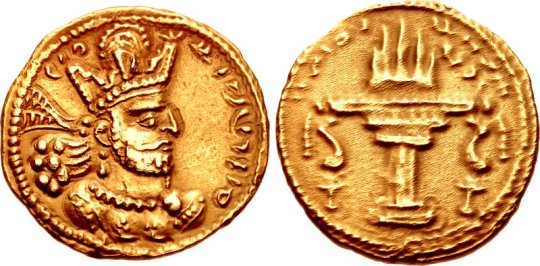
Gold coin of Shapur (Šābuhr) II "the Great," king of Sassanid Persia from 309 to 379 CE. On the obverse, the bust of Shapur, wearing a mural crown topped with the jewel-studded globe known as a korymbos; on the reverse, a fire altar, reflecting Shapur's aggressive promotion of Zoroastrianism within his realm. Artist unknown; minted ca. 320 CE and found in the present-day nation of Georgia. Photo credit: Classical Numismatic Group, Inc. http://www.cngcoins.com
#history#ancient history#Near East#Ancient Near East#Persia#Ancient Persia#Persian Empire#Sassanids#Sassanid Persia#Shapur II#art#art history#ancient art#Near Eastern art#Ancient Near Eastern art#Persian art#coins#ancient coins#numismatics#ancient numismatics#gold#goldwork#Zoroastrianism
153 notes
·
View notes
Text
„Another likely allusion to a Near Eastern story in the Iliad is Poseidon’s account of how he, Zeus and Hades divided the world by lot (Il. 15.185-195). … After Hera has seduced Zeus and put him to sleep, Poseidon helps the Greeks to regain the upper hand in the war. When Zeus wakes up, he is angry and sends the goddess Iris to tell Poseidon that he should withdraw from the battle and obey him. After Iris has reported Zeus’ words, Poseidon replies to her as follows: Well now, surely, though he is noble, he has spoken arrogantly, if by force and against my will he will restrain me who have equal honor with himself. For three brothers are we, begotten by Cronos, and born of Rhea—Zeus, and myself, and the third is Hades, who is lord of the dead below. And in three ways have all things been divided among us, and to each has been apportioned his own domain. I indeed, when the lots were shaken, won the grey sea to be my home for ever, and Hades won the murky darkness, while Zeus won the broad heaven in the air and the clouds; but the earth and high Olympus still remain common to us all. So I will in no way walk according to the will of Zeus; but at his ease let him remain in his third portion, no matter how strong he may be. Il. 15.185-195
Burkert was the first, to my knowledge, who recognized in the division of the world into three parts by Zeus and his brothers through the casting of lots a possible allusion to the Near Eastern story of Atrahasis, the man who survived the great flood. Close to the beginning of this story we are told that three generations of gods divided heaven, earth and sea also by the casting of lots: They had taken the [clay jar?] by the neck, They cast lots, the gods took their shares: Anu went up to heaven, [Enlil took the earth for his subjects, [The bolt], the trap of the sea, [They had given to Enki the leader. An even closer parallel may have existed in Ugarit, where the three sons of El, the father of the gods, divide the world among themselves: Baal, who is the equivalent of Zeus in several ways, rules the sky, Yam the sea, and Mot the underworld. The text is very fragmentary, however, and it is unclear if they did so by the casting of lots. If they did, it may well be that this is the version of the story on which Poseidon’s account is based.
This account differs fundamentally from the other Greek traditions we encounter in Homer or Hesiod relating to the manner in which power was distributed among the gods. In the Iliad Zeus claims to rule the gods because he is the eldest and the strongest of the Olympians. He says so to Iris just before Poseidon’s speech: And if he will not obey my words, but will disregard them, let him consider then in mind and heart lest, strong though he be, he has not the courage to face my reproach; since I say I am better far than he in might, and the elder by birth. Yet his heart does not hesitate at all to declare himself the equal of me, whom the other gods dread. Il. 15.162-167
Iris repeats the same words to Poseidon in lines 178-183 and after Poseidon’s speech she reminds him again that Zeus is the eldest and, because of this, his authority is upheld by the Erinyes (Il. 15.201-204). These statements do not match Poseidon’s claim that Zeus’ authority is restricted to the heavens and that he and Zeus have an equal say on earth and on Olympus. In the Theogony we are told that the Olympian gods, after they had defeated the Titans, asked Zeus to rule over them and that it was Zeus who divided their honours among them: When the blessed gods had completed their toil, and by force had reached a settlement with the Titans regarding honors, then by the prophecies of earth they urged far-seeing, Olympian Zeus to become king and to rule over the immortals; and he divided their honors well for them. Hes. Th. 881-885 No mention is made of the casting of lots, certainly not where Zeus’ domain or authority is concerned. Note that Zeus in this passage is already referred to as the ‘Olympian’ before any division is made. If the assumption is that the honours of the gods were divided by the throwing of lots, it appears that Zeus is presiding over this division, not participating in it, as also seems to be the case in Pindar’s Olympian 7.
For Poseidon’s claim that the three brothers divided the world by lot there is support in local Greek practice. It was common among the Greeks for brothers to divide parts of the inheritance by lot. Such a division assumes, however, that the brothers are more or less equal, but this is not the case with Zeus and his brothers. The portions in this case are far from equal too. In most other theogonic accounts from Greece, Zeus plays the leading role in establishing the rule of the Olympian gods. After the Olympian gods defeat the Titans, the other gods recognize him as their king, as Hesiod’s Theogony says. Is it really conceivable that Zeus subsequently would have cast lots, running the risk of winding up in the underworld or the sea, and relinquished his right to rule over the earth and Olympus? It is very difficult to reconcile Poseidon’s story with other extant accounts of how Zeus came to power. Later Greeks therefore could question it, as Callimachus does in his Hymn to Zeus.
Poseidon through this story claims that he and Zeus are equal partners and have an equal right to rule over the earth and Olympus. Is there any reason to think that Poseidon would make up such a claim?There is. Zeus at the end of his speech to Iris says about Poseidon: ‘his heart does not hesitate at all to declare himself the equal of me’ (Il. 15.166-167). Iris repeats these words to Poseidon in lines 182-183. What we subsequently get is a display of Poseidon’s tendency to declare himself the equal of Zeus. He does so explicitly in line 186: ‘[Zeus wrongs] me who has equal honour with him’. In support of this claim he recites an oriental cosmogony, in which gods share the world equally among themselves by lot, and presents it as something that really happened. Iris does not buy it, however. She asks Poseidon if he really wants her to relate these words to Zeus, because in her eyes they do not do justice to Zeus’ authority (Il. 15.201-204). Poseidon then relents: he says that he will obey and Iris should not tell the story to Zeus. All of this makes good sense if Poseidon is referring to a story that Homer’s audience would have recognized as a lie.”
-Eastern Myths for Western Lies: Allusions to Near Eastern Mythology in Homer's Iliad by André Lardinois
#the iliad#greek mythology#ancient near east#near eastern mythology#greek gods#poseidon#zeus#hades#quotes#excerpts
11 notes
·
View notes
Text


ignore me i’m crying at the british museum because of cylinder seals
#this is the thing that’s convinced me that i definitely want to do a phd/pursue assyriology#literally only went and looked at the ancient near east section and experienced love at first sight#cylinder seals#ancient Near East#Mesopotamia#akkadian cylinder seals#neo Sumerian cylinder seals#assyriology#archaeology
2 notes
·
View notes
Text

Under the adobe of Olympian palace 🏛️🏺🪔
Heavily inspired by Professor Jenks-Brown @greekmythcomix’s #Classicstober - even though deals with love magic, charms, amulets, & potions of the ancient Eastern Mediterranean-Near Eastern world (an idea from my friend, @aimee-maroux, who happened to be writing erotic stories of the Greek gods, also.)
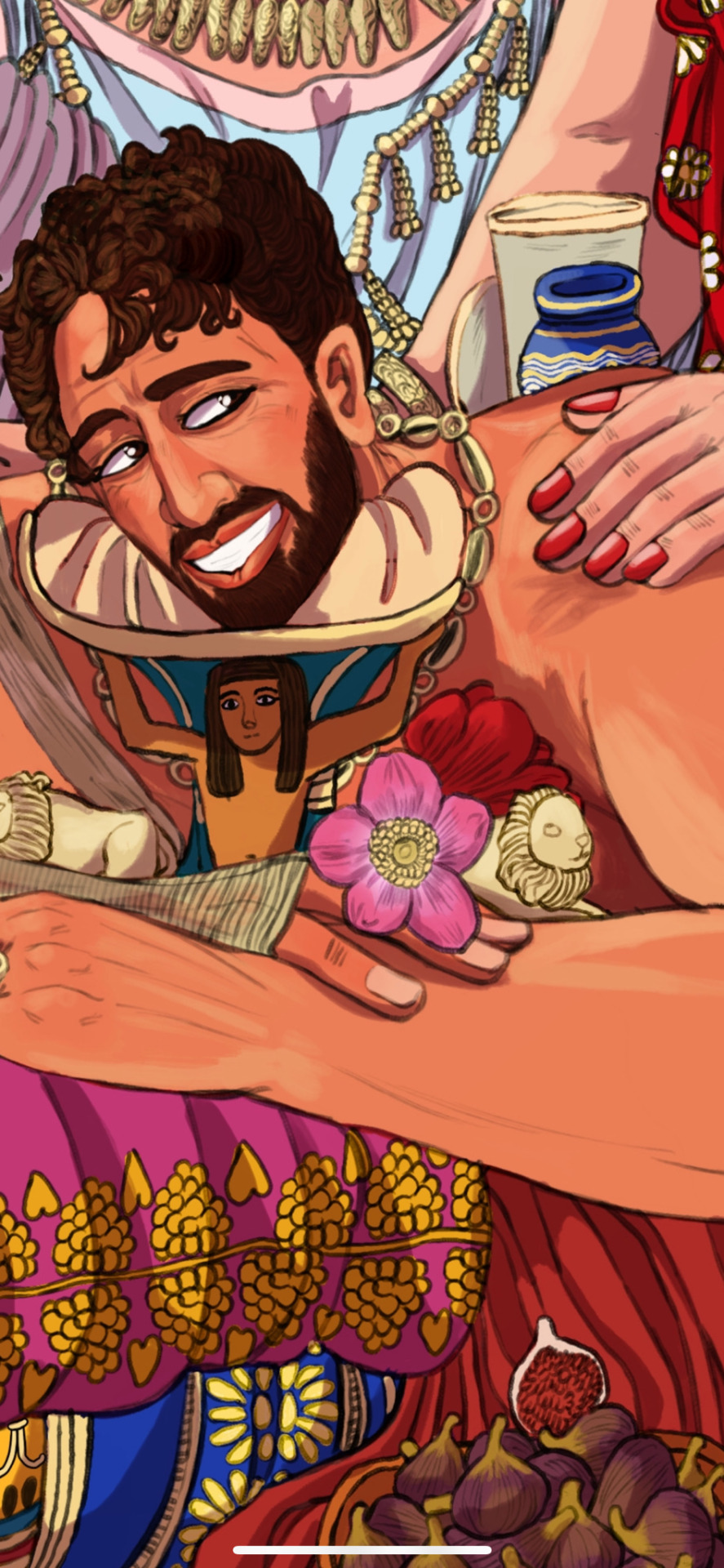
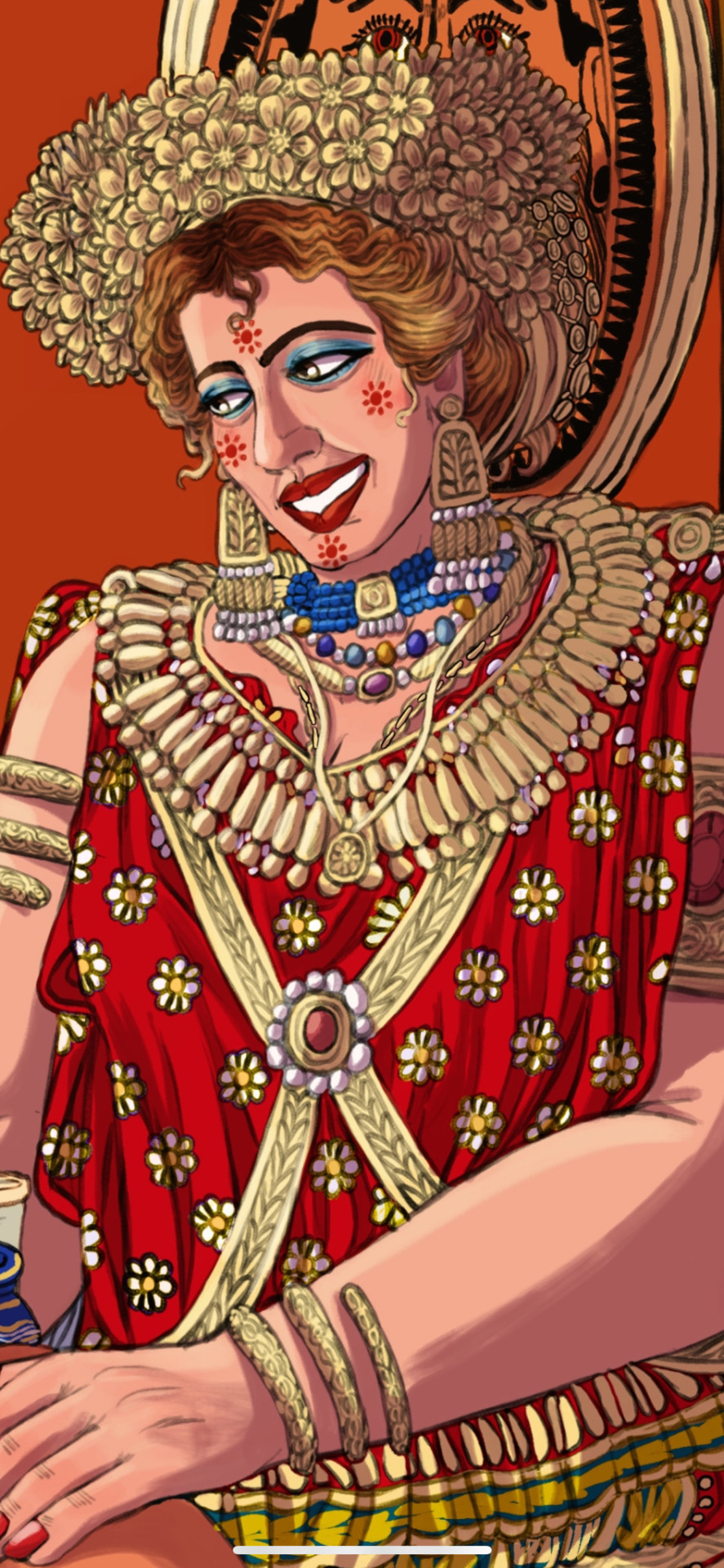
Ares feels worn down from carrying the heavy war armor and weapons all the time, while his wounds haven’t been healed enough yet. This often leads to Aphrodite’s messaging one of Ares’ wounds with her magic love potions/charms and both of them cuddling, smooching, and having their passionate nights later afterward. The magical love potions/charms of late antiquity are all Ancient Greek, Ancient Near Eastern (especially Babylonians, Assyrians and Phoenicians) & Ancient Egyptian; as her home, Cyprus is a melting pot of all of them.


From right to left on the 1st table: the Ancient Greek honey cheesecake, figs, pomegranates, dates, grapes, mandrakes, and Roman honey cookies (often filled with various types of nuts, opium seeds & almonds) While the mandrake tree - often associated with witchcraft & magic - wasn’t popular among the Ancient Greek society per se (as they often burning them as incense), it is widely used as a tree of love & fertility/ a fortune amulet in Ancient Egypt & Near East. As cousins of the nightshade, mandrake is both hallucinogenic & narcotic, and small usages of the tree have been used as a surgical anesthetic/ pain relief in ancient times. The 2nd table got the main vegetarian meal, of course: hearty red lentil saffron soup & Greek pita bread. I plan to add a silver tray of oysters to it, but I don't think it will fit in the aphrodisiac collection. The final table was filled with apples, wine & several love potions/ amulets that the goddess currently working on.
#ancient greek#aphrodite#ares#my art#mars#venus#ancient egypt#ancient near east#classicstober#classicstober2023#witchcraft#love magic#love charms#love amulet#love potion#Halloween
50 notes
·
View notes
Text
Ereškigal Festival


[Alt text is generated by iOS with minor proof read sorry if there are inaccuracies]
*screams* I finally found an actual source. "Ereškigal doesn't have cult worship" is bullshit, begone.
— From The Cultic Calendars of the Ancient Near East by Cohen pages 351 & 355
#polytheism#paganism#landof2rivers#Ereškigal#ereshkigal#myqueen#syrian#emar#ancient near east#mesopotamian#amorite#a physical copy of this book is $100+ 😒
18 notes
·
View notes
Text
While I agree that I did word myself thoughtlessly and should've been more sensitive to cultural context, I want to address these statements by Oldshrewsburyian:
"actually interested in exercising historical empathy and imagination."
and "This mixture of disdain and inattention does not strike me as a great start for a historical fantasy novel."
I've done as much research as I could for my fantasy novel, I've looked up sources and chatted with a historian specializing in ancient Persia to get an accurate image of things like court life, the rights and responsibilities of royal women etc.
This isn't meant to be me defending myself, I just want to make it clear that I truly wanted to respectfully portray the culture in my story and have spent a lot of effort in being as attentive to historical detail and cultural accuracy as I can.
As for my attitude towards the statement by rabbinical sage Rava, first I want to preface with the statement that the core of orientalism and prejudices about other cultures in general is projecting your own preconceived notions and fantasies onto another culture and making them seem exotic, mysterious and sexualized rather than like real, complex people.
As was said by Oldshrewsburyian, Rava was interpreting a text that was as far-removed from his own time and culture as it was to ours, and thus based his interpretations on what was normal to him rather than true for that time and place, to say nothing of the gender politics.
Likewise, in my conversation with the historian he told me that the writers of traditional commentary didn't capture the power and autonomy held by royal wives, such as being able to officiate state ceremonies and hold court in their own right when the king wasn't present, that "Neither Greek nor Hebrew accounts successfully capture this aspect of Achaemenid royal culture. Instead, they tend to portray Achaemenid royal women as achieving their political goals through illegitimate means and schemes, reflecting their own societies outlook on women and marriage more than anything that appears in Achaemenid domestic sources."
I've seen a post on fandom jumblr where the OP speculates what happened to Vashti after she was banished, stating that the most likely outcome is "living out the rest of her life in the harem where she was poisoned by a rival."
This statement exemplifies what I take issue with: it comes with an assumption of what life was like for royal women that has little resemblance to reality and is far more influenced by pop-culture than real history. The idea that the only options a queen would have after losing favor and becoming banished from the royal court would be living the rest of their lives doing nothing inside the harem, which ignores the fact that Persian women owned lands and property in their own right.
What bothers me is that people in modern times get a distorted view of history: when imagining what life was like for the people in the culture depicted they imagine things like luxury and court intrigue, but the actual lived reality and social culture gets left behind which creates a shallow, stereotypical image.
2 notes
·
View notes